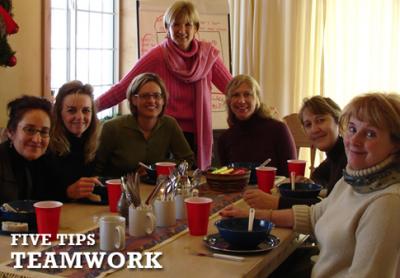5 Tips for Teams
Five Things You Should Know!

Ris Higgins and her husband started Leadership Outfitters, a Bozeman-based company, in 1992 to provide life-altering personal leadership development through coaching, retreats, assessments, and 1-on-1 coaching intensives.
For more, see www.leadership-outfitters.com.
Contact: [email protected], (406) 586-5504.
When that happens a team actually achieves more. Teams know when they have trust and when they don’t. What many don’t know is how to achieve it. As baseball great Casey Stengel observed, “Gettin’ good players is easy. Gettin’ ‘em to play together is the hard part.” But it doesn’t have to be. Try these five tips for starters. Share them with your team. Discuss what’s easy and what’s challenging. And then commit to using them for six months.What you notice will be the team transforming; what you watch will be inspiring.
1) Learn a variety of methods to get input from all team members.
It’s always handy to have a couple of group process practices in your back pocket should you find yourself facing a team that quietly stares back at you or has someone dominating the discussions. My favorite go-to practice is to put the team into pairs or trios, and ask them to discuss and come up with a suggestion, or idea, or contribution to the topic at hand. When I check in with each pair or trio, it never ceases to amaze me how much energy and engagement this set-up generates. It works because it enables team members to contribute without feeling put on the spot. Nobody wants to look stupid so when they have a partner to talk with, it takes away the spotlight.
2) Discuss the undiscussables.
If you don’t, it can sabotage the team because it undermines trust, the foundation of any team. Finding your way through this tip takes courage because most often fear is the reason an undiscussable exists as the “elephant in the room”. Sometimes the newest member of the team sees this “elephant” and is reluctant to bring it up to his seasoned team. I watched this happen with one of my clients as the team negotiated their departmental budgets. The team had been given their budget limits and all but my client came to the meeting with their budgets over the limit. He was incensed but didn’t say anything as he listened to all the justifications. In fact, he shut down because he didn’t see or hear anyone discuss the need to change, so he decided it was undiscussable.
Afterwards we talked about what he could do in the next weekly meeting to address his concerns. It was important that he bring up the undiscussable without finding fault. So when he brought up the issue, he explained his intention was to understand how this senior leadership team came to the numbers they did given the limits. He shared his concern about the impact of the budget overages to each other’s departments and to the organization as a whole, especially when raises were being decreased.
Then he said something like, “I’d like to know what each of you think about what I said and hear your point of view.” Then he listened and made sure he didn’t say any “Yes, buts.”
What happened surprised even him; his question changed the discussion. The team ended up talking about issues that were really behind the over-budgets. Instead of throwing more money at problems, they talked about how to resolve them. They experienced having a conversation that mattered. Doing so changed the team because a member was willing to discuss the undiscussables in a non-blaming and curious way.

3) Use curiosity to check out assessments and conclusions.
A team can get off track when a member digs in their heels to prove their conclusion is the right one. Getting curious about that point of view offers the team the opportunity to hear a new perspective. Here’s what curiosity sounds like: “Help me understand what you mean by that.” Or “How did you arrive at this conclusion? I’m not tracking with you and I want to understand.” It’s about letting your team member know you are not on board yet and you want help in understanding their point of view. If you are thinking this is hard to do, especially when you think you are right, it is. When that happens, remember this. It starts as an inside job. I have to remind myself, “This is my business partner, I respect him, and I know I need to find out why this makes sense to him. What is it I don’t see or understand?” That inside conversation serves as a humbling reminder.
4) If a team gets stuck, explore what you agree on and what you disagree on.
Don’t shelve the discussion and move on. Capture the agreements somewhere—on a flipchart or a whiteboard where everyone can see them. Get them out of people’s heads and onto a medium where revisions and comments can be made. That in itself is clarifying. Then do the same thing with the disagreements, listing them all opposite the list of agreements. Here’s what I’ve noticed happens. The team begins to focus on the business needs and interests, not defensive positioning. They begin to dislodge what was stuck by seeing what steps or actions could be taken to move a disagreement to an agreement. Because all the business needs and interests are out in the open, clarified, and discussed, all team members feel heard, making it easier to let go of a position. On a team, pain is inevitable; suffering, however, is optional. This practice makes it possible to move out of suffering and into action.
5) At the end of each meeting, confirm all decisions made and any next steps.
Then determine three things: 1) What information needs to be shared, 2) Who needs to know this information, and 3) What is the time frame for communicating this information? (I usually suggest within 24 hours). When associates are informed and involved, you provide clarity and alignment, while preventing resentment from associates feeling left out. The need for this tip became evident while I was working with a senior team who met before their executive VP could join them. When he arrived the next morning, he asked what they had achieved the day before as a way to bring him up to speed. To the astonishment of the five-member team, they each reported different outcomes. That’s when they realized how much confusion and misalignment they had been creating for their organization after their meetings.












Leave a Comment Here